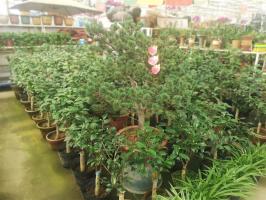Introduction
When it comes to indoor plants, potted plants are a popular choice. They add color and life to any space, and they can also improve air quality. With so many different types of potted plants available, it can be hard to identify each one. This article aims to help you identify potted plants and answer the question, "What type of potted plant is this?"
Factors for Plant Identification
There are several factors you should consider when trying to identify a potted plant. These include the plant's size, shape, color, texture, and growth habits. Additionally, you should consider the conditions in which the plant thrives, such as light, temperature, and water requirements. All of these factors can help you narrow down the type of potted plant you have.
Common Types of Potted Plants
There are countless types of potted plants, but some common ones include snake plants, peace lilies, spider plants, and English ivy. Snake plants are tall and narrow with long, pointy leaves that are dark green with light green stripes. Peace lilies have large, glossy leaves and white flowers. Spider plants have thin, spiky leaves with white stripes and small, spider-like plantlets that grow on long stems. English ivy has small, green leaves and grows well in hanging baskets.
Less Common Types of Potted Plants
If your potted plant is not one of the common types listed above, there are many other types it could be. For example, there are African violets, Chinese evergreens, rubber plants, and fiddle-leaf figs. African violets have small, delicate leaves and come in a variety of colors. Chinese evergreens have large, glossy leaves that are variegated with silver, white, or green. Rubber plants have thick, waxy leaves that are dark green or burgundy. Fiddle-leaf figs have large, fiddle-shaped leaves with a glossy finish.
Identifying Your Potted Plant
Now that you know some of the most common and less common types of potted plants, you can begin identifying your own. The first step is to observe the plant's physical characteristics and note its growth habits. Then, research the plant's environmental requirements to see if they match the conditions in which your plant is thriving. You can also take a photo of your plant and consult with a local garden center or online plant identification forum for assistance.
Caring for Your Potted Plant
Once you have identified your potted plant, it's important to understand its care requirements so that it can thrive in your home. Consider things like how much sunlight it needs, how often it should be watered, and what kind of soil it prefers. It's also important to fertilize your plant regularly and to take preventative measures against pests and diseases.
Conclusion
Identifying a potted plant can be a fun and rewarding experience. By observing the plant's physical characteristics and researching its environmental requirements, you can narrow down its identity and care for it properly. With a little love and attention, your potted plant will thrive and add beauty and life to your home.

 how many times do yo...
how many times do yo... how many planted tre...
how many planted tre... how many pine trees ...
how many pine trees ... how many pecan trees...
how many pecan trees... how many plants comp...
how many plants comp... how many plants can ...
how many plants can ... how many plants and ...
how many plants and ... how many pepper plan...
how many pepper plan...
































